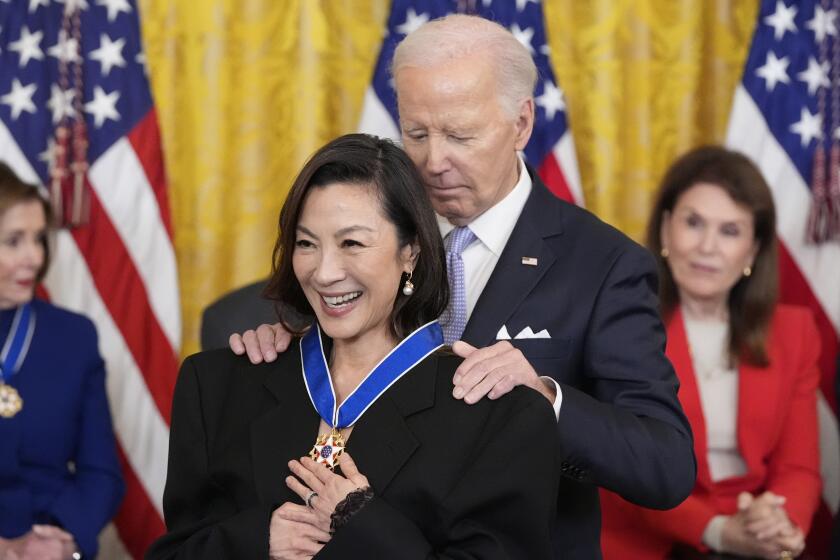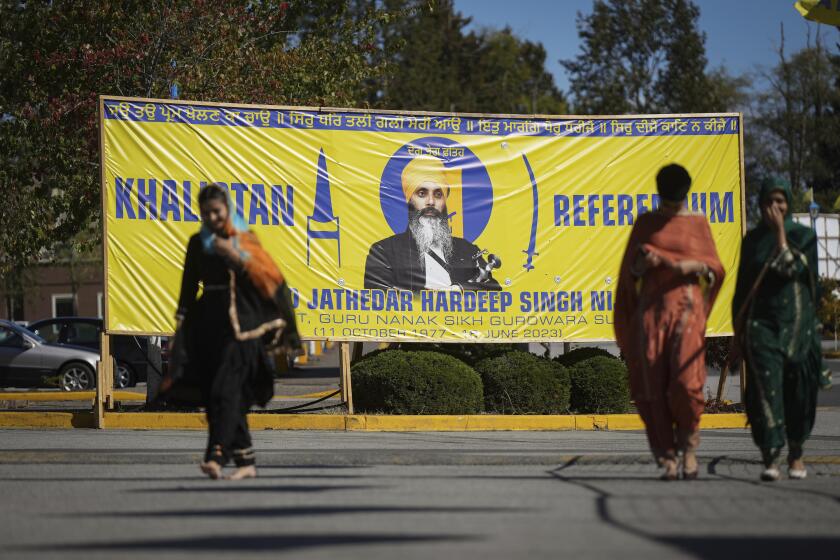M.F. Husain dies at 95; artist was called the Picasso of India
Reporting from Karachi, Pakistan, and New Delhi -- India’s most famous artist, M.F. Husain, often referred to as the Picasso of India, died Thursday in a London hospital. He was 95.
The cause of death was not immediately clear, although he was being treated for fluid in his lungs.
Husain left India in 2006, angered by Hindu hardliners who condemned his nude depictions of Hindu gods. Last year Husain, a Muslim, became a citizen of Qatar, dividing his time between homes there and in London.
During his lifetime, he painted an estimated 25,000 works that in his later years were commanding record sums in keeping with his growing fame. His epic work “Mahabharata: The Battle of Ganga and Jamuna” sold at a 2008 Christie’s auction for $1.6 million.
In the January-February 2011 issue of British cultural magazine Standpoint, critic Nick Cohen said Husain “may be the world’s greatest living artist.”
“Husain embodies the spirit of his country,” Cohen added. “The struggles, the optimism and glories of India flow through his work.”
India, the nation Husain felt betrayed by toward the end of his life, offered plaudits on Thursday.
Prime Minister Manmohan Singh termed his death a national loss, and President Pratibha Patil said it left a “void in the world of art.”
Husain’s painting, with its focus on color and lines, inspired by Cubism and the art of Hindu temples, gained wide attention in the 1950s. He received national recognition for his painting “Zameen” that, instead of bemoaning rural poverty and indebtedness, was a celebration of life, a common theme in his work.
As his reputation grew throughout the 1960s and 1970s, Husain showed a talent for hyping his life and escapades, which only raised the value of his work. “Life without a bit of drama is too drab,” he said on one occasion. “If I’d been in Europe, I would’ve been more gimmicky than Salvador Dali,” he said on another.
He also explored the film medium. In 1967, his first movie, “Through the Eyes of a Painter,” won the Golden Bear award at the Berlin Film Festival.
The paintings that would cause the greatest controversy and personal pain were mostly of Hindu deities. Although they were painted in the early 1970s, they didn’t get much attention until 1996, when a monthly Hindi magazine, Vichar Mimansa, printed them, leading to several lawsuits by outraged conservatives. Two years later, his house was attacked by Hindu groups who vandalized several of his works.
The cases were dismissed in 2004, but two years later more controversy erupted over his “Bharatmata,” or Mother India. The painting depicted a nude woman posing across a map of the country with the names of Indian states on her body, leading to legal charges that he’d “hurt the sentiments of people,” prompting a warrant and his decision to turn his back on India. In his later years, he expressed a desire to return.
Maqbool Fida Husain was born Sept. 17, 1915, in Pandharpur in the western state of Maharashtra. His mother died while he was still a boy. At 17, he won a gold medal at an art exhibition for an oil portrait and persuaded his father to send him to art school.
Two years later, however, his father lost his job, putting an end to Husain’s art studies. At 23, he got his first arts job painting cinema billboards for Bollywood. But, unable to make ends meet, he switched to designing and building toys.
Family and friends describe him as a wandering spirit, at times annoyingly so. His son Shamshad recounted to India Today magazine in 1979 how his father once asked the family to go for a drive, only to wander off for some tea while they were getting ready; he did not return for a week.
“We resented this at first and used to get very upset,” Shamshad said. “But now we are quite used to it. He doesn’t mean to hurt anyone or upset them. But he needs to be free.”
Husain had several instrumental women in his life. Because he lost his mother at an early age, her image infused many of his paintings. “As I do not recall my mother’s visage, most of my female figures have no face details,” he said in a 2005 interview.
During his billboard painting days in Bombay, he acquired a surrogate mother when a widow, Mehmooda Bibi, took pity on him, inviting him to eat with her family. Eventually he married her daughter, Fazila Bibi, and they had six children.
“My father could not have become what he is had it not been for our mother’s support,” their son Shamshad, also a painter, once said.
Husain’s most passionate love may have been Marie Zurkova, an interpreter whom he met in 1953 on a trip to Czechoslovakia, his first outside India. Husain reportedly gave her 50 paintings and proposed that she become his second wife. However, she eventually married someone else and moved to Australia.
Rana is a special correspondent.
Magnier reported from Karachi and Rana from New Delhi.
More to Read
Start your day right
Sign up for Essential California for news, features and recommendations from the L.A. Times and beyond in your inbox six days a week.
You may occasionally receive promotional content from the Los Angeles Times.






